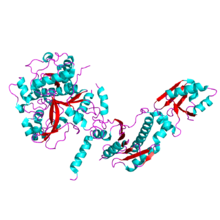| YcaO-like family | |||||||||
|---|---|---|---|---|---|---|---|---|---|
 Structure of the heterocyclase TruD. A YcaO-like protein from Prochloron sp. 06037A PDB entry 4bs9 Structure of the heterocyclase TruD. A YcaO-like protein from Prochloron sp. 06037A PDB entry 4bs9 | |||||||||
| Identifiers | |||||||||
| Symbol | YcaO | ||||||||
| Pfam | PF02624 | ||||||||
| InterPro | IPR003776 | ||||||||
| |||||||||
YcaO is a protein found in bacteria which is involved in the synthesis of thiazole/oxazole modified microcin antibiotics, such as bottromycin. YcaO performs ATP dependent cyclodehydration to form the oxazole and thiazole moieties of the microcin.
The YcaO name origin is from a gene naming rubric that was established from the bacterium Escherichia coli. If a gene has an unknown function, it was given a four-letter name starting with the letter Y and the next three letters are given based on the genomic location.
Methyl coenzyme M reductase (MCR) or Coenzyme-B sulfoethylthiotransferase is a protein known in thioamidation (a posttranslational modification). A Ycao enzyme dependent on ATP is needed for MCR thioamidation as well as a sulfide source. YcaO enzymes are needed to catalyze the ATP-dependent backbone cyclodehydration of polar amino acids such as Cysteine, Serine, and Threonine to the correct thiazoline and (methyl) oxazoline Heterocycle. The side chains of these amino acids can act as Nucleophiles. The Thiol group in cysteine and the hydroxyl group of serine and threonine are strong nucleophiles.
References
- Koehnke J, Bent AF, Zollman D, Smith K, Houssen WE, Zhu X, et al. (December 2013). "The cyanobactin heterocyclase enzyme: a processive adenylase that operates with a defined order of reaction". Angewandte Chemie. 52 (52): 13991–13996. doi:10.1002/anie.201306302. PMC 3995012. PMID 24214017.
- Dunbar KL, Melby JO, Mitchell DA (April 2012). "YcaO domains use ATP to activate amide backbones during peptide cyclodehydrations". Nature Chemical Biology. 8 (6): 569–575. doi:10.1038/nchembio.944. PMC 3428213. PMID 22522320.
- Dunbar KL, Chekan JR, Cox CL, Burkhart BJ, Nair SK, Mitchell DA (October 2014). "Discovery of a new ATP-binding motif involved in peptidic azoline biosynthesis". Nature Chemical Biology. 10 (10): 823–829. doi:10.1038/nchembio.1608. PMC 4167974. PMID 25129028.
- Koehnke J, Mann G, Bent AF, Ludewig H, Shirran S, Botting C, et al. (August 2015). "Structural analysis of leader peptide binding enables leader-free cyanobactin processing". Nature Chemical Biology. 11 (8): 558–563. doi:10.1038/nchembio.1841. PMC 4512242. PMID 26098679.
- Burkhart BJ, Schwalen CJ, Mann G, Naismith JH, Mitchell DA (April 2017). "YcaO-Dependent Posttranslational Amide Activation: Biosynthesis, Structure, and Function". Chemical Reviews. 117 (8): 5389–5456. doi:10.1021/acs.chemrev.6b00623. PMC 5406272. PMID 28256131.
- Mahanta N, Liu A, Dong S, Nair SK, Mitchell DA (March 2018). "Enzymatic reconstitution of ribosomal peptide backbone thioamidation". Proceedings of the National Academy of Sciences of the United States of America. 115 (12): 3030–3035. doi:10.1073/pnas.1722324115. PMC 5866606. PMID 29507203.
This biochemistry article is a stub. You can help Misplaced Pages by expanding it. |